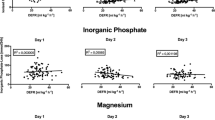Abstract
Objective: To determine to what extent hydrosoluble vitamins are removed by continuous renal replacement therapy (CRRT); to evaluate clearances, removal rates, and evolution of serum concentrations of folic acid and pyridoxal-5′-phosphate (P-5′-P), the active moiety of vitamin B6 during CRRT. Design: A prospective, non-interventional, descriptive study on vitamin losses induced by CRRT. Setting: Medical and surgical intensive care units in a tertiary university-affiliated hospital. Patients: A total of ten critically ill patients in oligoanuric acute renal failure (five treated by continuous venovenous hemofiltration and five by continuous venovenous hemodiafiltration) with a mean effluent rate of 1801 ± 468 ml/h. Nutritional support was not modified and additional vitamin supplements were not provided during study periods. Measurements and results: Concentrations of folic acid and P-5′-P were determined daily during CRRT. Samples for folic acid, P-5′-P, urea, and creatinine were taken simultaneously from the blood at the dialyzer inlet and from the effluent, at CRRT initiation, and daily thereafter over an average of 3.4 ± 1.2 days. Samples were processed by immunochemiluminescence for folic acid and by radioenzymatic assay for P-5′-P determinations with normal ranges above 6.8 nmol/l and from 11.5 to 179.3 nmol/l, respectively. Marked decreases in serum folic acid and P-5′-P concentrations were noticed over time with mean daily reductions of 12.6 and 13.7 %. Serum folic acid concentrations decreased from 42.7 to 16.0 nmol/l and serum P-5′-P decreased from 14.4 to 5.0 nmol/l in the blood coming in to the dialyzer over the study period. Clearances and removal rates were determined from the effluent side. During CRRT, mean (± SEM) folic acid and P-5′-P clearances were 20.5 ± 6.3 ml/min (n = 34) and 13.2 ± 10.6 ml/min (n = 22), whereas mean urea clearance was 27.1 ± 5.1 ml/min (n = 26). Folic acid and P-5′-P removal rates were 27.0 ± 34.2 and 3.4 ± 2.0 nmol/h, corresponding to mean daily losses of nearly 650 and 80 nmol/day respectively. Conclusion: Significant losses of folic acid and P-5′-P (and most likely of other hydrosoluble vitamins) occur during CRRT. Considering that stores of most hydrosoluble vitamins are relatively low in critically ill patients, supplementation should be provided to patients treated similarly.
Similar content being viewed by others
Author information
Authors and Affiliations
Additional information
Received: 30 December 1998 Final revision received: 15 March 1999 Accepted: 15 March 1999
Rights and permissions
About this article
Cite this article
Fortin, MC., Amyot, SL., Geadah, D. et al. Serum concentrations and clearances of folic acid and pyridoxal-5′-phosphate during venovenous continuous renal replacement therapy. Intensive Care Med 25, 594–598 (1999). https://doi.org/10.1007/s001340050908
Issue Date:
DOI: https://doi.org/10.1007/s001340050908




